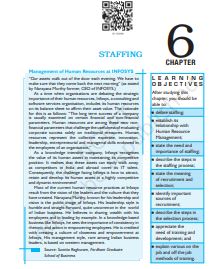‘NCERT Solutions for Class 12 Business Studies Chapter 6‘ PDF Quick download link is given at the bottom of this article. You can see the PDF demo, size of the PDF, page numbers, and direct download Free PDF of ‘Ncert Class 12 Business Studies Chapter 6 Exercise Solution using the download button.
Staffing NCERT Textbook With Solutions PDF Free Download

Chapter 6: Staffing
The foundation of any organisation is the talented and hardworking people, who are the principal assets of any firm. It is an established fact that the growth of an organisation requires the continual infusion of quality staff. Thus, adequate staffing or the provision of appropriate human
resources is an essential requirement for any organisation’s success. It is, therefore, believed that an organisation can achieve its objectives only when it has the right persons in the right
positions.
After planning and selecting of the organisation structure, the next step in the management process is to fill the various posts provided in the organisation. This is termed the management of staffing function. In the simplest terms, staffing is ‘putting people to jobs’. It begins with workforce planning and includes different other functions like recruitment, selection,
training, development, promotion, compensation, and performance appraisal of the workforce.
In other words, staffing is that part of the process of management which is concerned with obtaining, utilizing, and maintaining a satisfactory and satisfied workforce. Today, staffing may involve any combination of employees including daily wagers, consultants, and contract employees.
Staffing recognizes the importance of every single person employed by an organization as it is the individual worker, who is the ultimate performer Staffing has been described as the managerial function of filling and keeping filled the positions in the organisation structure.
This is achieved by, first of all, identifying requirements of the workforce, followed by recruitment, selection, placement, promotion, appraisal and development of personnel, to fill the roles designed into the organisation structure.
In a new enterprise, the staffing function follows the planning and organising functions. After deciding what is to be done, how it is to be done, and after the creation of the organisation
structure, the management is in a position to know the human resource requirements of the enterprise at different levels.
Once the number and types of personnel to be selected are determined, management starts with
the activities relating to recruiting, selecting, and training people, to fulfill the requirements of the enterprise. In an existing enterprise, staffing is a continuous process because new jobs may be created and some of the existing employees may leave the organisation.
| Author | NCERT |
| Language | English |
| No. of Pages | 30 |
| PDF Size | 2.6 MB |
| Category | Business Studies |
| Source/Credits | ncert.nic.in |
NCERT Solutions Class 12 Business Studies Chapter 6 Staffing
1. What is meant by staffing?
Staffing is a management function that involves hiring candidates suitable for the organization by evaluating their skills, and knowledge and offering specific roles as per their skill set. It is involved in the fulfillment of human resource requirements for an organization.
2. State the two important sources of recruitment.
Recruitment is the process of searching for and hiring the right person for the job. It can also be said to the process of finding potential candidates suitable for the job and convincing them to apply for the post. Two important sources of recruitment can be defined as:
1. Internal Sources
2. External Sources
Internal sources refer to as sources of recruitment within the organization. It means any vacancy created is filled by an existing employee working in the organization.
External sources of recruitment include hiring a new candidate either through agencies or conducting a direct hiring session.
3. The workers of a factory are unable to work on new machines and always demand the help of a supervisor. The Supervisor is overburdened with their frequent calls. Suggest the remedy.
This situation can be controlled by providing the workers with proper training regarding the use of machines. It will increase their confidence and skillset. It will also result in faster working with no delay in performing the task.
4. The quality of Production is not as per standards. On investigation, it was observed that most of the workers were not fully aware of the proper operation of the machinery. What could be the way to improve the quality of production to meet the standards? (training).
The quality of the production can be improved by offering training to employees. This can be on-the-job training where there will be a master worker whose role will be to train the employees in the use of machinery.
The employees can learn and practice under the guidance of master-worker for a period of time before working individually. This type of training will help an employee to work efficiently.
5. The workers of a factory remain idle because of a lack of knowledge of hi-tech machines. Frequent visit of an engineer is made which causes high overhead charges. How can this problem be removed?
This kind of problem is dealt with by providing workers with proper training. These workers can be provided vestibule training which will reduce the frequent visits of the engineer.
Vestibule training is the kind of training where the workers are made to practice on dummy machines which are models of industrial equipment that the workers need to work on.
Once they gain adequate exposure, the workers can be shifted to the factory to perform the work.
NCERT Class 12 Business Studies Textbook Chapter 6 With Answer PDF Free Download
